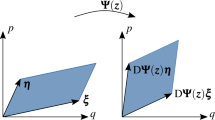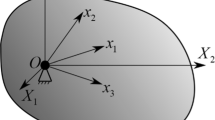Abstract
A unified geometric formulation of the methods used for solving constrained system problems is given. Both holonomic and nonholonomic systems are treated in like manner, and the dynamic equations are expressible in either generalized velocities or quasi-velocities. Moreover, a wide range of ’unconstrained‘ systems are uniformly regarded as generalized particles in the multi-dimensional metric spaces relating to their configuration. The derivation is grounded on the tensor calculus formalism and appropriate geometric interpretations are reported. In its useful matrix form, the formulation turns out short, elementary and general. This unified geometric approach to constrained system dynamics may deserve to become a generally accepted method inacademic and engineering applications.
Similar content being viewed by others
References
Orlandea, N., Chace, M.A. and Calahan, D.A., ‘A sparsity-oriented approach to the dynamic analysis and design of mechanical systems, Parts I and II’, Journal of Engineering for Industry 99, 1977, 773–784.
Wittenburg, J., Dynamics of Systems of Rigid Bodies, Teubner, Stuttgart, 1977.
Wehage, R.A. and Haug, E.J., ‘Generalized co-ordinate partitioning for dimension reduction in analysis of constrained dynamic systems’, Journal of Mechanical Design 104, 1982, 247–255.
Nikravesh, P.E., Computer-Aided Analysis of Mechanical Systems, Prentice Hall, Englewood Cliffs, 1988.
Kim, S.S. and Vanderploeg, M.J., ‘A general and efficient method for dynamic analysis of mechanical systems using velocity transformations’, Journal of Mechanisms Transmissions, and Automation in Design 108, 1986, 177–182.
Hemami, H. and Weimer, F.C., ‘Modelling of nonholonomic dynamic systems with applications’, Journal of Applied Mechanics 48, 1981, 177–182.
Wampler, C., Buffinton, K. and Shu-hui, J., ‘Formulation of equations of motion for systems subject to constraints’, Journal of Applied Mechanics 52, 1985, 465–470.
García de Jalón, J., Unda, J. and Avello, A., ‘Natural co-ordinates for the computer analysis of multibody systems’, Computer Methods in Applied Mechanics and Engineering 56, 1986, 309–327.
García de Jalón, J., Unda, J., Avello, A. and Jiménez, J.M., ‘Dynamic analysis of threedimensional mechanisms in “natural” co-ordinates’, Journal of Mechanisms, Transmissions, and Automation in Design 109, 1987, 460–465.
Walton, Jr., W.C. and Steeves, E.C., ‘A new matrix theorem and its application for establishing independent co-ordinates for complex dynamical systems with constraints’, NASA Technical Report TR R-326, 1969.
Mani, N.K., Haug, E.J. and Atkinson, K.E., ‘Application of singular value decomposition for analysis of mechanical system dynamics’, Journal of Mechanisms, Transmissions, and Automation in Design 107, 1985, 82–87.
Singh, C.L. and Likins, P.W., ‘Singular value decomposition for constrained dynamical systems, Journal of Applied Mechanics 52, 1985, 943–948.
Kim, S.S. and Vanderploeg, M.J., ‘QR decomposition for state space representation of constrained mechanical dynamic systems’, Journal of Mechanisms, Transmissions, and Automation inDesign 108, 1986, 183–188.
Amirouche, F.M.L., Jia, T. and Ider, S.K., ‘A recursive Householder transformation for complex dynamical systems with constraints’, Journal of Applied Mechanics 55, 1988, 729–734.
Liang, C.G. and Lance, G.M., ‘A differentiable null space method for constrained dynamic analysis’, Journal of Mechanisms, Transmissions, and Automation in Design 109, 1987, 405–411.
Agrawal, O.P. and Saigal, S., ‘Dynamic analysis of multi-body systems using tangent coordinates’, Computers & Structures 31, 1989, 349–355.
Kane, T.R. and Levinson, D.A., ‘Formulation of equations of motion for complex spacecraft’, Journal of Guidance and Control 3, 1980, 99–112.
Desloge, D.A., ‘The Gibbs–Appell equations of motion’, American Journal of Physics 56, 1988, 841–846.
Kurdila, A., Papastavridis, J.G. and Kamat, M.P., ‘Role of Maggi's equations in computational methods for constrained multibody systems’, Journal of Guidance, Control, and Dynamics 13, 1990, 113–120.
Schiehlen, W. (ed.), Multibody System Handbook, Springer-Verlag, Berlin, 1990.
Scott, D., ‘Can a projection method of obtaining equations of motion compete with Lagrange's equations?’, American Journal of Physics 56, 1988, 451–456.
Lesser, M., ‘A geometrical interpretation of Kane's equations’, Proceedings of the Royal Society, London A436, 1992, 69–87.
Essén, H., ‘On the geometry of nonholonomic dynamics’, Journal of Applied Mechanics 61, 1994, 689–694.
Synge, J.L. and Schild, A., Tensor Calculus, University of Toronto Press, Toronto, 1949.
Arnold, V.I., Mathematical Methods of Classical Mechanics, Springer-Verlag, New York, 1989.
Maisser, P., ‘Analytische Dynamik von Mehrkörpersystemen’, ZAMM (Zeitschrift f ¨ur Angewandte Mathematik und Mechanik) 68, 1988, 463–481.
Cardin, F. and Zanzotto, G., ‘On constrained mechanical systems: D'Alembert's and Gauss' principles’, Journal of Mathematical Physics 30, 1989, 1473–1479.
Pobedrya, B.E., Lectures on Tensor Analysis, Moscow University Publishers, Moscow, 1974.
Petzold, L.R., ‘Methods and software for differential-algebraic systems’, in Real-Time Integration Methods for Mechanical System Simulations, E.J. Haug and R.C. Deyo (eds.), NATO ASI Series F, Vol. 69, Springer-Verlag, Berlin, 1990, 127–140.
Baumgarte, J., ‘Stabilization of constraints and integrals of motion in dynamical systems, Computer Methods in Applied Mechanics and Engineering 1, 1972, 1–16.
Blajer, W., ‘A projection method approach to constrained dynamic analysis’, Journal of Applied Mechanics 59, 1992, 643–649.
Neimark, J.I. and Fufaev, N.A., Dynamics of Nonholonomic Systems [in Russian], Moscow University Publishers, Moscow, 1967.
Blajer, W., ‘Projective formulation of Maggi's method for nonholonomic systems analysis’, Journal of Guidance, Control, and Dynamics 15, 1992, 522–525.
Blajer, W., Schiehlen, W. and Schirm, W., ‘Projective criterion to the co-ordinate partitioning method for multibody dynamics’, Archive of Applied Mechanics 64, 1994, 86–98.
Blajer, W., ‘An orthonormal tangent space method for constrained multibody systems’, Computer Methods in Applied Mechanics and Engineering 121, 1995, 45–57.
Arczewski, K. and Blajer, W., ‘A unified approach to the modelling of holonomic and nonholonomic mechanical systems’, Mathematical Modelling of Systems 2, 1996, 157–174.
De Boer, R., Vector-und Tensorrechnung für Ingenieure, Springer-Verlag, Berlin, 1982.
Author information
Authors and Affiliations
Rights and permissions
About this article
Cite this article
Blajer, W. A Geometric Unification of Constrained System Dynamics. Multibody System Dynamics 1, 3–21 (1997). https://doi.org/10.1023/A:1009759106323
Issue Date:
DOI: https://doi.org/10.1023/A:1009759106323




